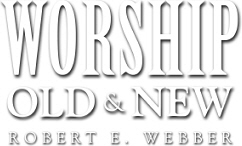
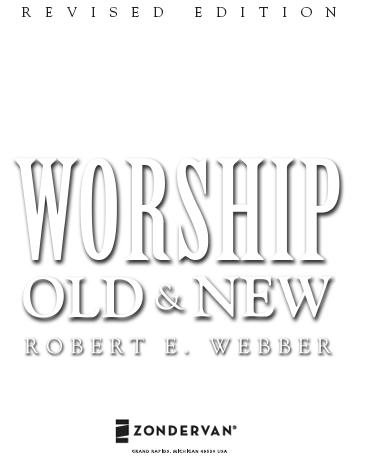
ZONDERVAN
WORSHIP OLD & NEW
Copyright 1994 by Robert E. Webber
All rights reserved under International and Pan-American Copyright Conventions. By payment of the required fees, you have been granted the non-exclusive, non-transferable right to access and read the text of this e-book on-screen. No part of this text may be reproduced, transmitted, down-loaded, decompiled, reverse engineered, or stored in or introduced into any information storage and retrieval system, in any form or by any means, whether electronic or mechanical, now known or hereinafter invented, without the express written permission of Zondervan.
ePub Edition July 2009 ISBN: 978-0-310-83512-7
Requests for information should be addressed to:
Zondervan, Grand Rapids, Michigan 49530
Library of Congress Cataloging-in-Publication Data
Webber, Robert
Worship, old and new / Robert Webber. Rev. and expanded ed.
p. cm.
Includes bibliographical references and index.
ISBN 0-310-47990-8
1. Public worship. 2. Evangelicalism. I. Title
BV15.W4 1994
94-12730
264 dc20
All Scripture quotations, unless otherwise noted, are taken from the Holy Bible, New International Version. NIV. Copyright 1973, 1978, 1984, by International Bible Society. Used by permission of Zondervan. All rights reserved.
NIV and New International Version are registered in the United States Patent and Trademark Office by the International Bible Society.
All rights reserved. No part of this publication may be reproduced, stored in a retrieval system, or transmitted in any form or by any meanselectronic, photocopy, recording, or any otherexcept for brief quotations in printed reviews, without the prior permission of the publisher.
Edited by Matthew Maloley
01 02 03 04 05 06 /  DC / 17 16 15 14 13 12 11 10 9
DC / 17 16 15 14 13 12 11 10 9
Dedicated to my sister and her husband
Eleanor and Nelson Entwistle
in appreciation for the warm hospitality
they have shown to many people and
especially for the love and tender
care given to our parents in their
maturing years.
CONTENTS
In the preface to the first edition of Worship Old and New, I wrote: the primary value of the book is as a classroom text in seminary and college courses on worship. However, it should also be of interest to pastors, Christian education directors, worship committees, and laypersons who wish to be more informed on the subject.
In this second edition of Worship Old and New, I have resisted the temptation to write a simplistic and popular introduction to worship. Instead, I have maintained the scholarly flavor of the book and continue to see it as an academic introduction to the vast field of worship studies.
Since Worship Old and New was published eleven years ago, an enormous quantity of books covering every aspect of worship has emerged. Additionally, the fires of worship renewal have spread in every direction. I have interacted with this renewed interest in worship in this revised edition. While a good portion of the original text has been maintained, the entire work has undergone significant revision.
The material has been reorganized into four major divisions: The Biblical Foundations of Worship, A Biblical Theology of Worship, A Brief History of Worship, and The Practice of Worship.
The biblical portion of the book has been strengthened with the addition of a new chapter on the biblical themes of worship and with a more thorough chapter on Old Testament worship.
I have also reorganized the theological material and expanded the historical material to include a chapter on the renewal movements of the twentieth century.
The section on the practice of worship contains the most significant changes. Here, I have attempted to provide not only an academic understanding of worship but a perspective through the eyes of the worship leader and the worshipers.
I hope these improvements in Worship Old and New will make the work more useful for classroom study and a helpful guide for the practitioners of worship who wish to improve the worship of the local church.
Finally, I wish to add a word of thanks to my editor, Matthew Maloley, and to Dr. Richard Leonard, who offered many suggestions for the improvement of this second edition of Worship Old and New.
Robert Webber
On a recent visit to San Francisco I had a Sunday open to visit the church of my choice. Looking in the yellow pages I found an advertisement for St. Gregory Nyssen Episcopal Church that asserted we follow an early church model of worship with full congregational participation and involvement.
A visit to this church validated the advertisement. This church had a highly participatory and engaging style of worship. The congregation first gathered around a large table at the east end of the church. There we practiced the Alleluias we were to sing in the service. Worship then began with an entrance hymn and we all processed in a dance movement to the worship space for the service of the Word. After completing the entrance rites, we sat facing each other and listened to the Word of God read from a lectern flanked by African flags. After each Scripture reading a Tibetan gong was rung, and as its sound passed through the room, we meditated on the words we had heard. After the sermon, which was preached sitting down (an ancient custom), the congregation was invited to respond. One by one the people stood and responded. Some asked questions and received an answer. Others spoke of needs met or awakened. Still others spoke of how God had spoken to them through the sermon or how God was present in their struggles. After the service of the Word we processed with congregational dance back to the table. Standing around the table, we passed the peace of Christ, gave thanks over the bread and wine, partook, and then sang and danced around the table. Finally, a benediction was given and then bread, cheese, and fruit were brought to the table for all to eat and enjoy.
A similar experience occurred at Christ Church in Nashville, a large Pentecostal church that is moving toward what it believes to be the worship of the early church. Every Sunday morning this church celebrates a special Eucharist during the Sunday School hour for those wishing to participate. On the first Sunday of every month the entire congregation celebrates the Eucharist.
The service of the Eucharist began with spirited singing hymns, choruses, psalms, and songs particular to the Pentecostal tradition. The singing was followed by a time of prayer during which we gathered in small circles, held hands, and prayed for each other. We then heard and responded to two Scripture readings that were followed by a brief sermon. Then the pastor called the people to gather around the table of the Lord. Again we sang and sang. The pastor led us through a confession of sin using the Book of Common Prayer and then asked if anyone present was in need of healing. Several people came and knelt for the anointing with oil and the laying on of hands by the pastor. The congregation then received the bread and wine while songs of resurrection and exaltation were sung. As we left, we greeted each other with the peace of Christ.
I have described two Christian traditions on opposite ends of the Protestant spectrum one a liturgical church and the other a Pentecostal church. Yet both of them have moved from the particular style of their tradition to a new style, a style that has numerous common elements. This phenomenon, which is happening in nearly every denomination and all around the world, can be explained by three interrelated statements:
Next page
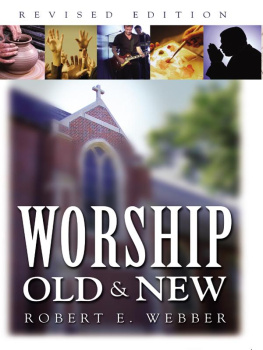
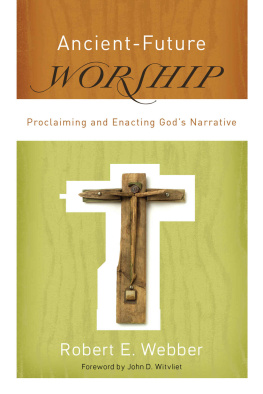
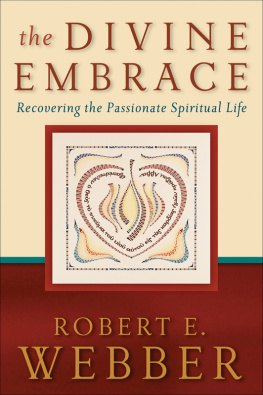
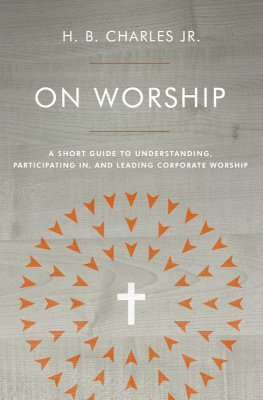
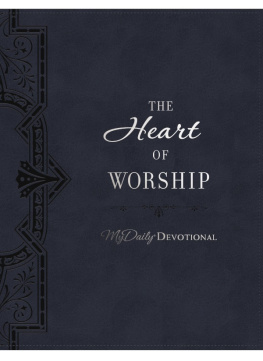
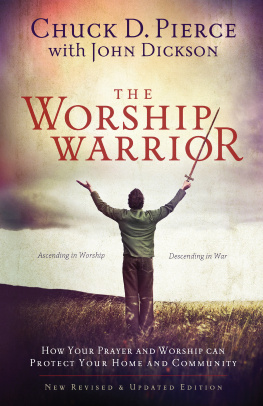



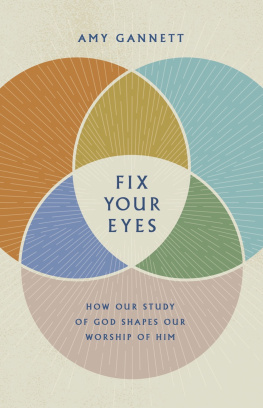
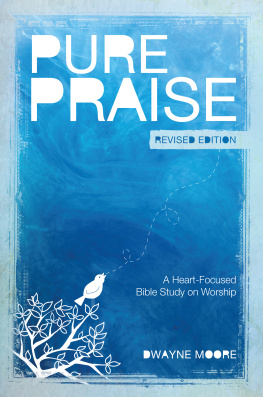
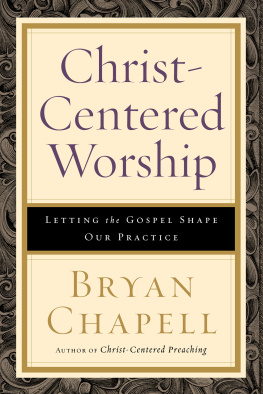
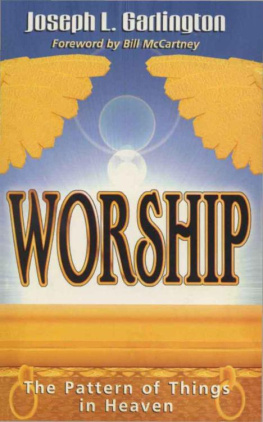



 DC / 17 16 15 14 13 12 11 10 9
DC / 17 16 15 14 13 12 11 10 9